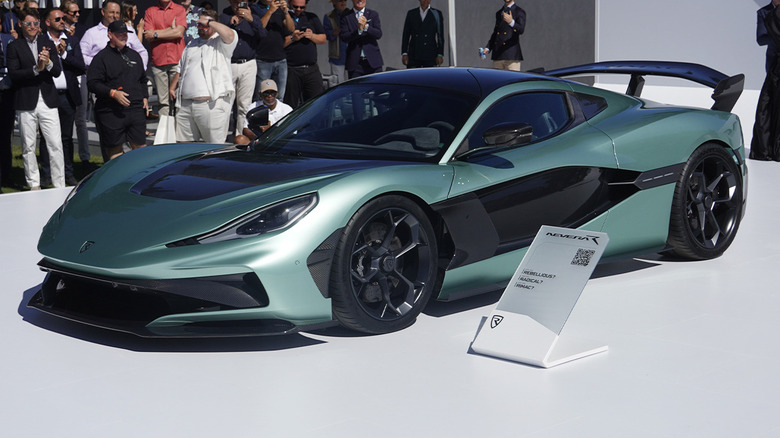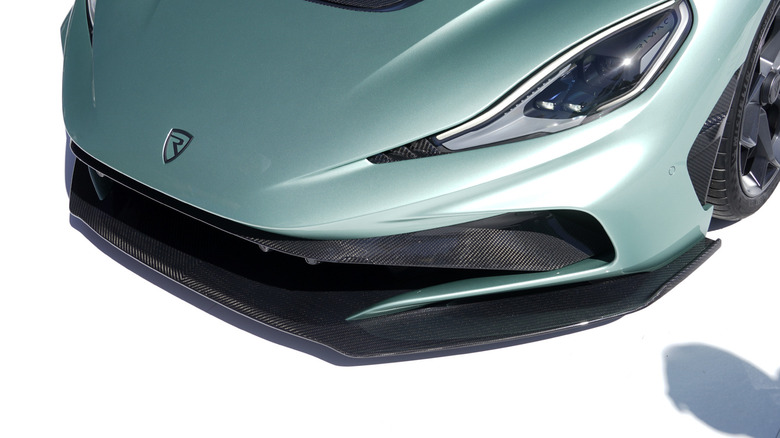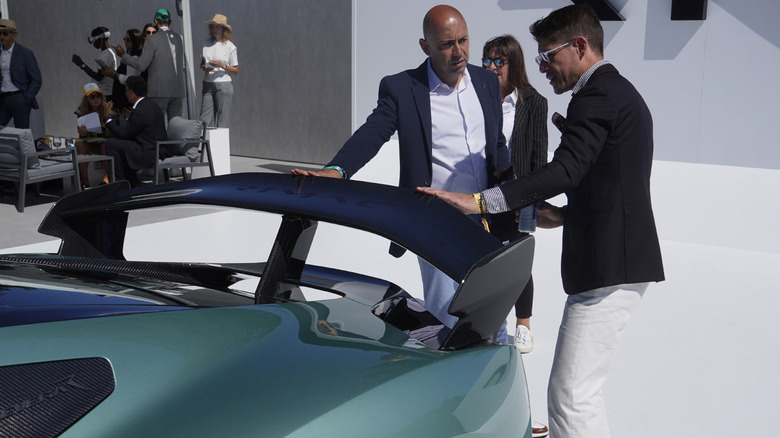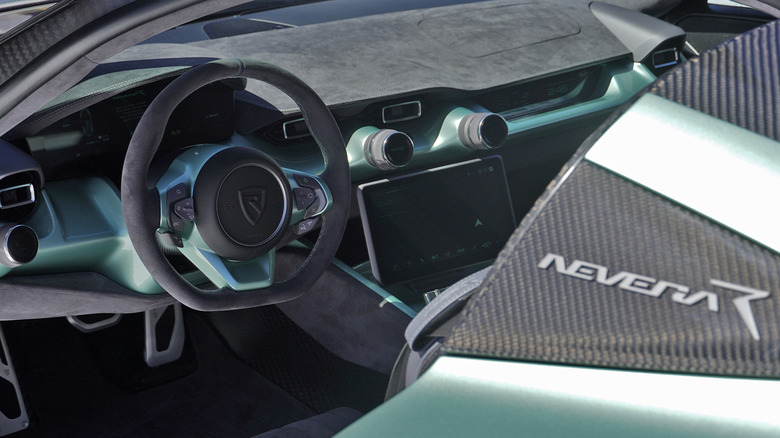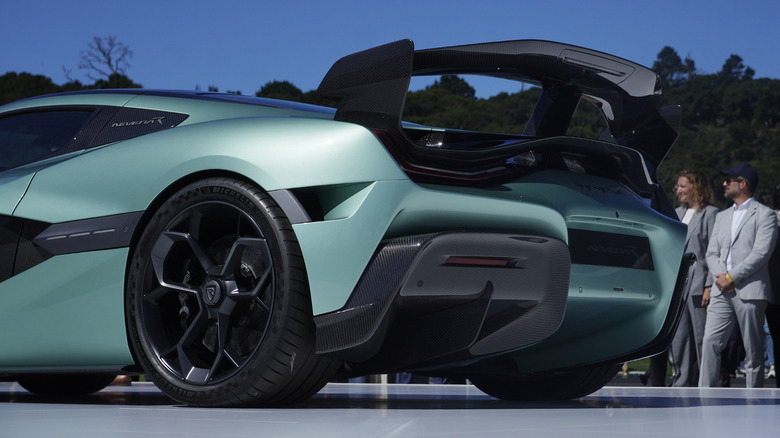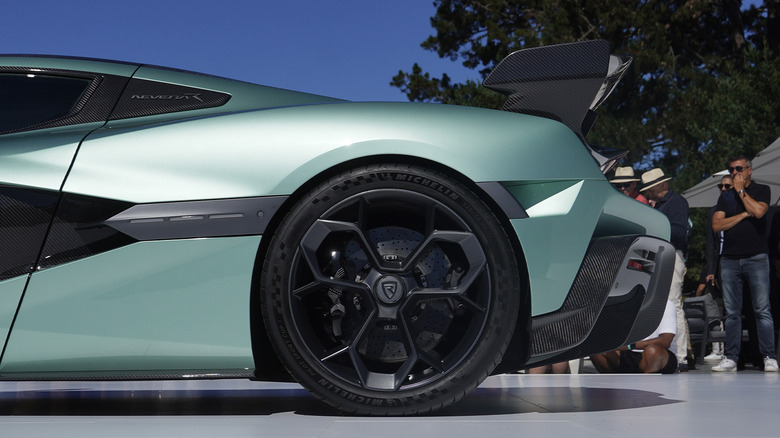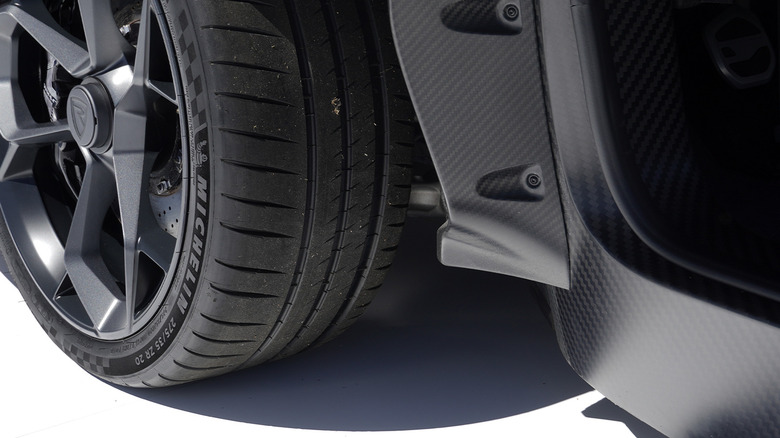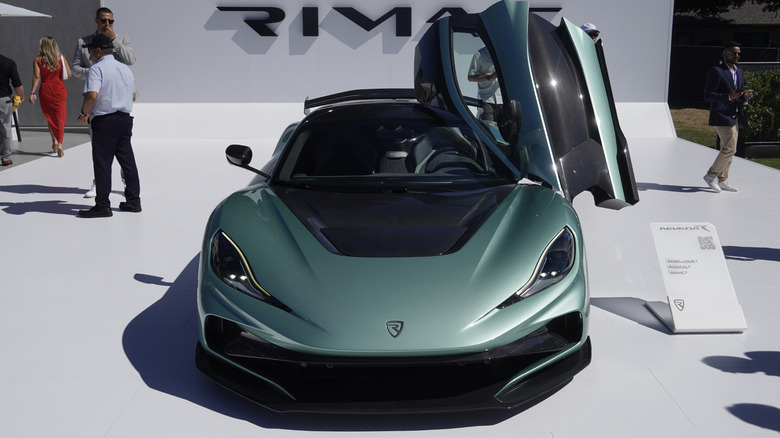2025 Rimac Nevera R First Look: Numbers To Make Your Head Spin (And How They Did It)
Last year at Monterey Car Week, I drove the Rimac Nevera Time Attack Edition, which celebrated a record-setting EV lap around the Nurburgring. As the quickest production car of all time, with impressive handling to match such brutal acceleration, the Nevera literally left my neck sore for days afterward.
As fast as the Nevera might be, however, eponymous founder Mate Rimac has admitted that sales have been a bit slow. Perhaps the prospect of an all-electric hypercar at this price point just pales in comparison to V12-powered (or W16, or V16) internal-combustion drama. The Nevera definitely attempts to spread the gospel of electric technology, and the results cannot accurately be called anything but impressive, but the design also looked slightly outdated. Perhaps too understated, if anything, for a car priced well into the seven figures.
Now, at this year's incarnation of The Quail, a Motorsports Gathering, Rimac unveiled a new R spec for the Nevera that solves many of those concerns. A new design emphasizes the transition to a sportier ethos that matches an upgraded drivetrain with more power, more advanced battery technology allowing for better charging, and physical upgrades to performance parts, as well. The result arrived in Monterey ready to prove itself even faster, and of course, more expensive, as well. On the immaculate lawns of The Quail, I quizzed Bugatti (and now Rimac) designer Frank Heyl about how the Nevera R attempts to improve something already so undeniably impressive.
Redesigning a world-beater
The Nevera still looks similar, for anyone following along, but with noted improvements that add a more dynamic element from almost every viewing angle. Hints of McLaren and possibly Lotus Emira inspiration shine through, especially on the new clamshell-style nose, but I wanted to know how Heyl adapted to working on an existing model from an existing automaker.
"It's really like painting on two canvases," Heyl laughed. "As you know, I am with the Bugatti brand now since 16 years. So I've been doing combustion-engine cars for the longest part of my career, and grown through that."
"Yes, they're both hypercars, but they serve two completely different niches and there's also completely different personalities of customers that buy these things," he continued. "It's super interesting, I'm learning from it. I'm an auto didact, almost engineer actually, all these years in sitting in these engineering meetings. I didn't study engineering, however, I had to become almost an engineer myself."
Adding downforce without reducing efficiecny
The front end's style points add up, without a doubt, yet the revisions also contribute to improved aerodynamics. At the rear, a new two-level wing features exit ducts for radiators and, of course, additional downforce that Rimac claims has increased by 15% while simultaneously improving efficiency by 10%. The larger diffuser works in concert with that wing to further increase downforce—a theme develops—and testing apparently shows the Nevera R's lateral grip at 5% better than the "base" model, with a concomitant 10% reduction in understeer.
"We wanted to create 15% more downforce," Heyl posed, as a rhetorical challenge. "Okay, what do we have to do to do that?"
"It's quite an iconic rear wing, if you will. Two end planes, really prominently, and then we have a central pillar one. It's a biplane, so you have the top layer and there's a second layer underneath, which is also fully detached from the main volumes. So the rear glass goes underneath the second advanced kind of wing, and it gives the rear end a completely different look as well."
The wing needs to complement the diffuser perfectly, so I asked how much form followed function, or vice versa, while working on such a complex wing that needs to look good while improving downforce and cooling simultaneously.
A cohesive perspective required
"You can only do these things if you completely understand all of its technologies working to all of its proportional aspects, working with all of its stylistic aspects," Heyl admitted. "That principle you apply to Bugatti, you can also apply the same principle to the Nevera R now."
Other than design and aerodynamic improvements, the Nevera R also features a new battery with 108 kilowatt-hours of capacity. Those cells still sit within the chassis in more of a dogbone layout versus the by-now-traditional skateboard layout preferred by most EV manufacturers. Of course, the Nevera isn't most EVs, and the battery can now crank out up to 1.55 megawatts of juice. The two motors up front can now put out 270 Newton-meters (or just shy of 200 lb-ft of torque) each, plus the rear duo now peak at 900-Nm (664 lb-ft). In total, the Nevera R ratchets up the insanity to a total tally of 2,107 horsepower.
Those numbers step up significantly from the previous Nevera, which nobody ever called anything like slow thanks to 1,914 total horsepower. Rimac's performance estimates similarly improve, though marginal gains at this level of output still largely revolve around tire technology, so Rimac installed a set of Michelin Pilot Sport Cup 2s in place of the 4S rubber on my tester last year.
Performance beyond specs on paper
A 0-60 sprint now clocks in at 1.74 seconds, or five-hundredths of a tick faster than the previous car, while running out to 186 miles an hour (the critical 300 kph mark, for metric fans) takes just 8.66 seconds. A quarter mile flies by even quicker, at just 8.23 seconds, and–when supervised by Rimac staff for safety reasons–the top speed extends to 256 miles per hour. Otherwise, customers can expect a Nevera R to stop pulling at what must be an extremely disappointing 217 miles per hour.
As much as hard pulls in the Nevera R can set impressive straight-line sprinting times, which will likely all stand as new world records, Heyl also emphasized how much the new batteries also extend the Nevera's performance window for repeated lapping. Switching from lithium nickel cobalt aluminum oxide (NCA) to lithium nickel cobalt manganese oxide (NMC) chemistry helps, in addition to the increased power, helps to prevent heat concerns from requiring any throttle back of pace.
"I used to have electrical engineering as a subject during my studies and I never used it," laughed Heyl. "So now I get to talk about milliamp-hours and ohms and resistance."
"We went from a 4,800-milliamp-hour capacity cell to a 4,500-milliamp-hour capacity cell, which has much less resistance," he said, turning more scientific. "And the drop in range is really marginal. However, you can extract, draw, and charge into the battery and take current out of the battery without heating it up so much."
Mate Rimac teases a race program
Given a run with good weather, and those new Cup 2 tires, the Nevera's Nurburgring lap time should therefore drop dramatically, as well. New carbon-ceramic brakes will help to rein in the additional output and prevent heat soak affecting longer stints for an EV that weighed over 5,000 pounds originally, and likely still does.
"The electric motors are the same. However, we can drive them harder because the battery can supply more current at the same time without overheating. Obviously it's all submerged in oil and cooled and just kept at the perfect temperature."
Just adding more power and endurance, in addition to the design elements, might have been enough for the Nevera R. But as more proof of concept to emphasize that Rimac still wants to push the envelope, the torque vectoring software also steps into new generation—largely to optimize the new Cup 2 tires. Revisions to the steering setup came into play, necessarily, and the drift mode needed recalibration given the additional grip. Those changes might not have ever come to fruition if Heyl hadn't applied the cohesive overall vision and knowledge.
Builds already underway
"Yes, we have one inch bigger wheels on the rear, but at the same time, we shrink wrap the wheel arches around it," he explained. "When we are fully understanding all the kinematics of how the control arms move, we can shrink wrap the wheel envelopes really tightly around that rubber. And so we actually created better stance not by necessarily only putting on bigger wheels, but also by making the wheel arches around them wrap more tightly. So that really improves the stance."
Mate Rimac explained that the Nevera R already began production at the company's new campus in Croatia, using around 20-30% new parts versus the base model (which will continue production, as well). Some of those parts include what Rimac described as the largest carbon structure of any production vehicle ever, and the stiffest with over 2,200 carbon plies. Yet I got a bit of a sidestep when I asked for any details regarding suspension revisions to cope with the added power, downforce, presumed cornering load, and braking.
Instead, Rimac emphasized the Nevera's existing variance in the many drive modes, which I admit impressed me last year. Maybe operating within the performance window of a 5,100-pound EV already presented enough of a challenge to suspension development that the system can already handle a bit more marginal gain. And, in something of a surprise, the founder then teased a potential race program for another more aggressive Rimac car, presumably based on the Nevera R but perhaps featuring an even more aggressive aero package.
Will buyers materialize for the Nevera R?
Some side effects of the improved tech also fit into Rimac's announcement. The Nevera R is reportedly now the fastest charging EV in the world, still capable of up to 500-kilowatt charge rates but, as with discharging at peak output, now able to hold that max rate for longer—assuming a charger actually existed for customers that could put out that many electrons.
And of course, this kind of performance and style comes at a significant premium, even on top of the current Nevera's stunning pricetag. The R now starts at 2.3 million euros, or 300,000 euro more than a "base" car. The limited run of 40 units will count toward the total of 150 planned Neveras (of all variants, including my Time Attack tester), which may provide some inkling as to how many units Rimac already moved in the past few years.
Whether customers will flock to a newly revamped electric hypercar remains to be seen. Without a doubt, the Bugatti Tourbillon sitting nearby attracted more attention other than during Rimac's dedicated press conference. Regardless, Rimac hopes deliveries will hopefully begin early next year, but in the meantime the new Nevera R proves that Mate Rimac's attention hasn't been entirely focused on Bugatti and the continued relationship with Porsche-VAG. Clearly, improving upon his first world-beating EV still occupies plenty of time and energy (pun, as always, fully intended).
